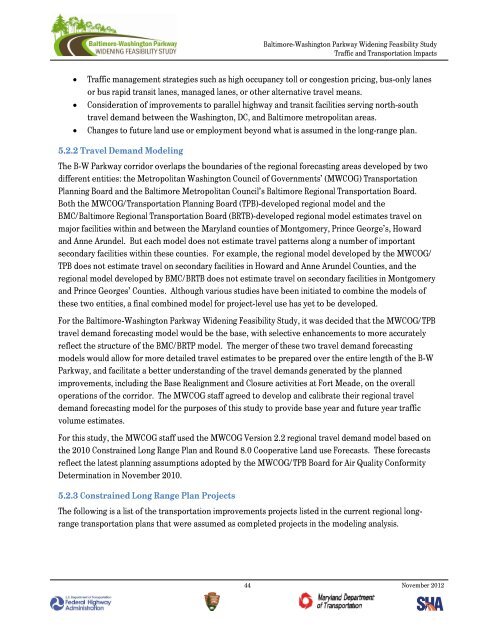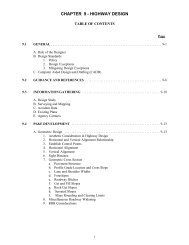Baltimore-Washington Parkway Widening Feasibility Study
Baltimore-Washington Parkway Widening Feasibility Study
Baltimore-Washington Parkway Widening Feasibility Study
- No tags were found...
You also want an ePaper? Increase the reach of your titles
YUMPU automatically turns print PDFs into web optimized ePapers that Google loves.
<strong>Baltimore</strong>-<strong>Washington</strong> <strong>Parkway</strong> <strong>Widening</strong> <strong>Feasibility</strong> <strong>Study</strong>Traffic and Transportation ImpactsTraffic management strategies such as high occupancy toll or congestion pricing, bus-only lanesor bus rapid transit lanes, managed lanes, or other alternative travel means.Consideration of improvements to parallel highway and transit facilities serving north-southtravel demand between the <strong>Washington</strong>, DC, and <strong>Baltimore</strong> metropolitan areas.Changes to future land use or employment beyond what is assumed in the long-range plan.5.2.2TravelDemandModelingThe B-W <strong>Parkway</strong> corridor overlaps the boundaries of the regional forecasting areas developed by twodifferent entities: the Metropolitan <strong>Washington</strong> Council of Governments’ (MWCOG) TransportationPlanning Board and the <strong>Baltimore</strong> Metropolitan Council’s <strong>Baltimore</strong> Regional Transportation Board.Both the MWCOG/Transportation Planning Board (TPB)-developed regional model and theBMC/<strong>Baltimore</strong> Regional Transportation Board (BRTB)-developed regional model estimates travel onmajor facilities within and between the Maryland counties of Montgomery, Prince George’s, Howardand Anne Arundel. But each model does not estimate travel patterns along a number of importantsecondary facilities within these counties. For example, the regional model developed by the MWCOG/TPB does not estimate travel on secondary facilities in Howard and Anne Arundel Counties, and theregional model developed by BMC/BRTB does not estimate travel on secondary facilities in Montgomeryand Prince Georges’ Counties. Although various studies have been initiated to combine the models ofthese two entities, a final combined model for project-level use has yet to be developed.For the <strong>Baltimore</strong>-<strong>Washington</strong> <strong>Parkway</strong> <strong>Widening</strong> <strong>Feasibility</strong> <strong>Study</strong>, it was decided that the MWCOG/TPBtravel demand forecasting model would be the base, with selective enhancements to more accuratelyreflect the structure of the BMC/BRTP model. The merger of these two travel demand forecastingmodels would allow for more detailed travel estimates to be prepared over the entire length of the B-W<strong>Parkway</strong>, and facilitate a better understanding of the travel demands generated by the plannedimprovements, including the Base Realignment and Closure activities at Fort Meade, on the overalloperations of the corridor. The MWCOG staff agreed to develop and calibrate their regional traveldemand forecasting model for the purposes of this study to provide base year and future year trafficvolume estimates.For this study, the MWCOG staff used the MWCOG Version 2.2 regional travel demand model based onthe 2010 Constrained Long Range Plan and Round 8.0 Cooperative Land use Forecasts. These forecastsreflect the latest planning assumptions adopted by the MWCOG/TPB Board for Air Quality ConformityDetermination in November 2010.5.2.3ConstrainedLongRangePlanProjectsThe following is a list of the transportation improvements projects listed in the current regional longrangetransportation plans that were assumed as completed projects in the modeling analysis.44 November 2012
















